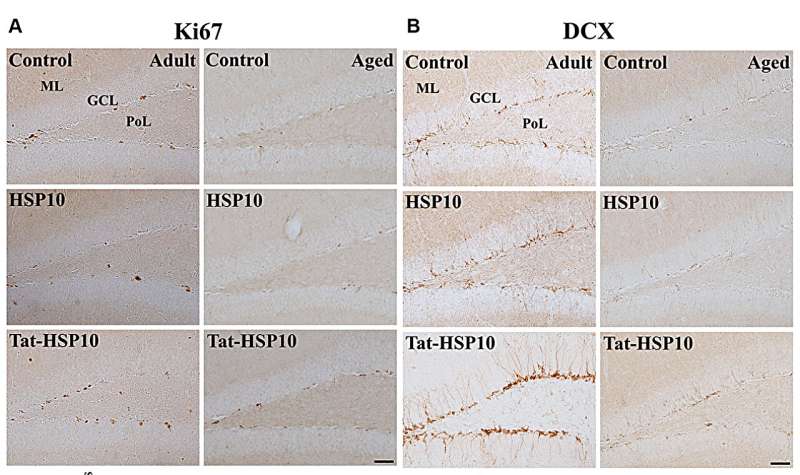This article has been reviewed according to Science X's editorial process and policies. Editors have highlighted the following attributes while ensuring the content's credibility:
fact-checked
proofread
Study: Tat-heat shock protein 10 ameliorates age-related phenotypes in the hippocampus

A new research paper, titled "Tat-heat shock protein 10 ameliorates age-related phenotypes by facilitating neuronal plasticity and reducing age-related genes in the hippocampus," was published in the journal Aging
In this new study, researchers from Seoul National University, Chungnam National University, Gangneung-Wonju National University, Hallym University, and Konkuk University investigated the effects of heat shock protein 10 (HSP10) protein on memory function, hippocampal neurogenesis, and other related genes/proteins in adult and aged mice.
"In the present study, we investigated the effects of HSP10 on hippocampal function in both adult and aged mice," the researchers write.
To translocate the HSP10 protein into the hippocampus, the Tat-HSP10 fusion protein was synthesized, and Tat-HSP10, not HSP10, was successfully delivered into the hippocampus based on immunohistochemistry and western blotting. Tat-HSP10 (0.5 or 2.0 mg/kg) or HSP10 (control protein, 2.0 mg/kg) was administered daily to 3- and 21-month-old mice for 3 months, and observed the senescence maker P16 was significantly increased in aged mice and the treatment with Tat-HSP10 significantly decreased P16 expression in the hippocampus of aged mice.
In novel object recognition and Morris water maze tests, aged mice demonstrated decreases in exploratory preferences, exploration time, distance moved, number of object contacts, and escape latency compared to adult mice.
Treatment with Tat-HSP10 significantly improved exploratory preferences, the number of object contacts, and the time spent swimming in the target quadrant in aged mice but not adults. Administration of Tat-HSP10 increased the number of proliferating cells and differentiated neuroblasts in the dentate gyrus of adult and aged mice compared to controls, as determined by immunohistochemical staining for Ki67 and doublecortin, respectively.
Additionally, Tat-HSP10 treatment significantly mitigated the reduction in sirtuin 1 mRNA level, N-methyl-D-aspartate receptor 1, and postsynaptic density 95 protein levels in the hippocampus of aged mice. In contrast, Tat-HSP10 treatment significantly increased sirtuin 3 protein levels in both adult and aged mouse hippocampus. These suggest that Tat-HSP10 can potentially reduce hippocampus-related aging phenotypes.
"Our results suggest that Tat-HSP10 treatment facilitates mitochondrial function, and Tat-HSP10 supplementation ameliorates the aging phenotypes in the mouse hippocampus," the authors conclude.
More information: Hyo Young Jung et al, Tat-heat shock protein 10 ameliorates age-related phenotypes by facilitating neuronal plasticity and reducing age-related genes in the hippocampus, Aging (2023). DOI: 10.18632/aging.205182




















